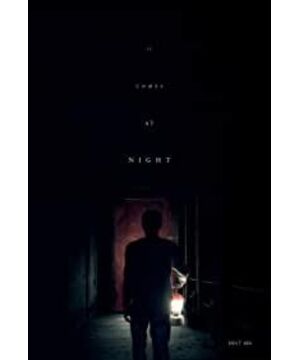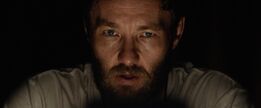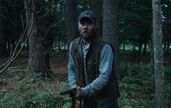"It Comes at Night" is probably one of the most surprising horror films in the second half of this year.
The film has a freshness of 89% on Rotten Tomatoes and a high score of 78 on MTC, a gathering of film critics, but only 5.8 on a domestic website.
The fundamental reason is that "Night Visit" belongs to the type of psychological fear, boring, slow-heating, and intrusive, rather than the kind of sensory stimulation film that shows off makeup and plasma.
The picture of "Night Visit" is very interesting. In order to render the atmosphere, most of them use light and dark contrast, lighting to show the scene inside the house, that is, outdoor, and also choose dark and grayish cool tones to enhance the atmosphere.
The film’s sense of fear is similar to that of "Escape from Dead End", which was popular a year ago. It uses psychological offensives to continuously exert pressure on a deeper spiritual level. Relying on excellent scene layout and metaphorical editing, There are also three dreams, the story that promotes, enhances the tension of the plot, and makes the degree of horror gradually rise, accumulate to the final, and suddenly erupt.
Without plasma and exaggerated makeup, how to intimidate the audience?
"Night Visit" first enhances the texture of the set.
80% of the time of the film takes place in the dark, either in a dark room surrounded by wooden boards, or in a mysterious woods.
Whether at home or outdoors, it gives people a sense of insecurity.
This uneasy feeling that may fall into danger at any time continues to create anxiety and panic for the audience.
At home, characters often use flashlights and mobile table lamps as light sources. The audience's visual range is always limited. Outside the lights are large unknown darkness, hiding the threats that may appear at any time.
The most important prop in the film is the red wooden door that connects to the outer room. It is one of the few barriers between a safe home and the dangerous outside world.
In the film, many times from the first-person perspective to push the folding fan metaphorically obvious red door, and the opening and closing of this door is also the turning point of the key plot, combined with the film ranking It Comes at Night, what does this IT refer to, this door? It also symbolizes what is really intriguing.
A careful audience will definitely notice the multiple use of the film editing process of overlapping shadows.
The first scene in the film is a tomb where the corpse is processed, and the next superimposed scene is the home that the protagonists think is safe.
From the grave to the home, it indicates that "bad events" are about to happen, that IT is about to come, the footsteps of death are approaching, and the story has entered the next more complicated stage.
In addition, the film begins with death, and also ends with death. In this beginning and the end, the characters change, the story falls from fear to warmth to desperate design, revealing endless darkness.
The sunshine that symbolizes life seems to have never appeared in the film.
Darkness always shrouded the surroundings, covering the hearts of the characters.
The most amazing thing about "Night Visit" is the design of three dreams.
The story of the film is not complicated at all, and the structure is so small that it is a bit surprising.
The story shows a virus attacked the end of the world. The Paul family lived tenaciously in their home in the forest.
The beginning of the film described the terrible virus to us. The older generation of Paul's family was affected by the virus. In the end, they had to isolate and even use weapons to end the life of this relative.
This cast a shadow on the heart of Travis, the son of the family.
Travis brought the three dreams and even the key conflicts of the film.
In the first stage of the dream, Travis dreams of his lost grandfather with a hideous face. It is a reconstructed dream of the conflict between the threat of the virus and the nostalgia of his loved ones.
After this dream, the motivational event happened, strangers broke into their home, and Andrew's unexpected visit disrupted their peaceful lives.
After torture and quarantine, Paul dubiously took Andrew and his family back. They were ambushed on the way, and Paul killed both of them.
Subsequently, a total of 6 people from the two families lived in harmony in the hut.
The two families continued to get along with each other, and Andrew and Travis established a friendly relationship between brother and father.
In the second dream, when he was young, Travis dreamed of Andrew's young wife Kim. When the two were about to have a physical relationship, Kim vomited blood.
This dream declared a gap that highlights the friendly relationship.
Sure enough, the turning event happened. Travis’s pet dog ran to the jungle alone and disappeared. When he returned home again, he was infected. Travis believed that Andrew’s young son might first come into contact with the dog and opened the red door. Be infected by this.
At this time, the third dream appeared. Travis walked out of the hut alone in his dream. After a dog bark, he vomited blood and became infected... After
this dream, the plot gradually got out of control. The Paul family was right. The Andrew family lost their trust and the ending climaxed. In a chaos, under the weight of fear, the Paul couple killed the Andrew family.
The three dreams from Travis are the escalation of fear and herald the trend of the plot.
After each dream, the plot will go down and the characters will encounter crisis.
At the same time, the three dreams have gone through the process of visit-contact-infection. The protagonist Travis was eventually infected by the virus. At the end, Paul's family may also be killed by the virus.
Among them, the film designed a big foreshadowing, whether the red door was opened by Andrew's youngest son;
whether Travis's third dream is a metaphorical dream or a partially empathic dream of real reality.
The film created a lot of conflicts in the third act, but it was the situation of Andrew's younger son that was pointed out, which created ambiguity and made the audience guess.
No matter what the truth is, Travis's words do irreversibly change the relationship between the storyline and the characters.
His words are an important reason for the desperate ending of the film.
The story of "Night Visit" is undoubtedly a genre of psychological fear that exposes a dark scene of human nature under the assumption of extreme extremes.
It has no grand narrative background, and tightly locks the perspective in the family life of six people.
This small format has instead increased the richness of the film's derivative meaning. Many fans can see the big picture from the small and can add more themes to the film through self-subjective "fill in the blanks".
The Paul family, a white man and a black family, the sudden intrusion of a white family, the control and distribution of food and water, the red fans, the dangerous forest, etc. are all symbolic elements that can be widely interpreted.
"Night Visit" thus creates an invisible sense of fear, and the source of the film's fear is not only the invasion of an unknown virus, but also the devastating oppression brought about by the crisis of trust.
In the film, the sense of trust is too difficult to build, and Paul always distrusts Andrew.
Travis, who seemed to have completely trusted Andrew, immediately changed his camp after feeling the threat of the virus, and announced the death penalty to the Andrew family like rain.
Trust is extremely difficult to build, but too easy to destroy.
Using the desire to survive, torturing the dark side of human nature, and inspiring potential demons in people's hearts, this is the means by which "Night Visit" continuously creates a sense of terror.
View more about It Comes at Night reviews











